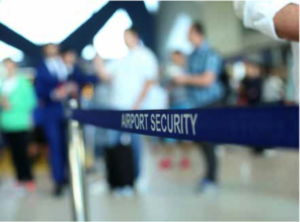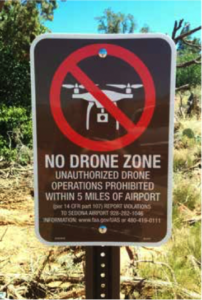All airplane flights begin on the ground. An airport is the starting point, but airspace issues continue to expand from the terrestrial to the aerial. Altitude is no barrier when countries claim sovereignty from the Earth to beyond the stratosphere.

© COLICARANICA – DREAMSTIME.COM
Airport control relies on readily available methods, from the mundane (like fences and doors with alarms) to the invisible (surveillance cameras and motion detectors). Security methods continue to evolve, but most experts agree the best deterrence takes place before a would-be miscreant ever gets to the terminal. Screening passengers (not to mention crew and airport staff ) for contraband is routine if overrated. We all know of mistakes by Transportation Security Administration personnel who’ve let potential hazards pass by unnoticed — and nothing bad has happened.
“Security is both a feeling and a reality, and the two are different things. People can feel secure when they’re actually not, and they can be secure even when they believe otherwise,” noted Bruce Schneier, a self-described public- interest technologist who works at the “intersection of security, technology, and people.”
He pointed out, “Airport security is the last line of defense, and it’s not a very good one. What works is investigation and intelligence: security that works regardless of the terrorist tactic or target.”
Kevin Garrison, a retired senior airline captain who writes frequently about aviation, predicted, “Security will have to become invisible and so easily done that nobody thinks about it anymore.”
Keep in mind airplane terrorism has always been incredibly rare. According to Schneier, “The risk is no greater today than it was in previous decades.” He noted the drive to the airport is still more dangerous than the flight. According to the Highway Loss Data Institute, there were 33,654 fatal motor vehicle crashes in the United States in 2018, in which 36,560 deaths occurred. This resulted in 11.2 deaths per 100,000 people. Aviation deaths? Fewer than 400 in 2018, said the National Transportation Safety Board. The overwhelming majority of aviation fatalities involve small, private airplanes and not large commercial airliners.
Airports are slowly renovating to provide more amenities to their highest revenue passengers, from dedicated check-in desks to chauffeured rides across the tarmac at flight departure. Lounge construction continues. At Tokyo’s Haneda Airport, Delta Air Lines started construction on a new Sky Club set to open in early July. (The carrier transferred its Tokyo-bound flights from Narita Airport to Haneda earlier this spring.)
Airports represent the public face of air travel, and the International Air Transport Association expects some $1.2–1.5 trillion to be spent on global airport infrastructure development in the coming decade. Meanwhile, airlines also work to make timely operational projections available to passengers. Delta, for instance, launched SkyWatch Daily Outlook to provide its customers with timely information on flight delays and cancellations.
What about after takeoff ? The airspace just above airports has been under assault from birds (think about geese sucked into airplane engines), not to mention the potential dangers of drones and laser pointers.
Airports have tried a variety of methods to scare birds away, from fireworks to loud noises, but one of the most successful seems to be the use of falconers and their birds of prey. Falcon Environmental Services’ wildlife control officers do the job at Toronto Pearson International Airport and Montréal’s Pierre Elliott-Trudeau International. Trained dogs also have been successful in chasing birds from runway areas.

© EMILY743 – DREAMSTIME.COM
As for drones, federal rules forbid operating a drone within five miles of most airports or above 400 feet without a waiver from the Federal Aviation Administration. You must get permission in advance from air traffic control to fly in the controlled airspace of an airport — and that’s only possible if you already have a Remote Pilot Certificate and are following Part 107 of FAA regulations. Drone experts think the airport sightings reported thus far are in the same category as UFO sightings. As Vic Moss, a founder of Drone U, a drone-operator school based in Albuquerque, New Mexico, said, “It’s possible, but it’s just incredibly unlikely that it was an actual drone.”
Lasers? Most laser pointers aren’t powerful enough to reach an aircraft in flight. During takeoff and landing, however, planes are closer to the ground, and it’s possible (although unlikely) to angle a laser such that it interferes with a pilot’s vision — though it is difficult to keep a handheld laser focused on a moving target.
In the air, commercial jets fly routes around the world, including high above some hot spots such as the Crimea, Iraq and Libya. Despite a handful of high-profile incidents (such as the targeting of a Ukrainian commercial airliner departing from Tehran recently, and the downing of a Korean Airlines passenger jet when it inadvertently strayed into restricted Russian airspace in 1983), the dangers are seen as almost negligible because each airliner’s route is calibrated to avoid recently determined no-fly zones.
What’s ahead? In the short term, airlines are reassessing their reliance on the hub-and-spoke routing that’s become routine in recent years. It’s increasingly seen as inefficient both in flying time for passengers and fuel use by aircraft, noted Garrison, the retired pilot.
Other guesses? Hyper loop or just super-fast trains connecting cities with larger airports. Right now, for example, if it takes five hours or less to drive between destinations, driving is faster than flying, once you calculate transit time to and from airports, check-in times and time in the air. Anyone who’s ridden the rails in China, Japan or much of Europe knows high-speed train travel can prove more efficient than flying and can free up airspace gridlock issues resulting from rapid aviation growth, another issue facing the industry.
The IATA recently inked a global intermodal memorandum of understanding with the International Union of Railways specifically to work on coordination. The airport at Frankfurt-am-Main, for example, includes a train station served by long-distance, high-speed trains.
“The United States still has the safest, most efficient airspace and airports in the world,” noted Shelly deZevallos, president, West Houston Airport. However, she said, “The last major airport built in the United States was in 1995 — Denver International — more than 15 years ago. This in no way keeps up with our aviation growth needs.”
Urban Air Mobility is one up-and-coming development requiring redesigned airports, she reported. NASA defines UAM as “a safe and efficient air transportation system where everything from small package delivery drones to passenger- carrying air taxis is operating above populated areas.” Changes in airport layout would be critical for its success: Instead of terminals between runways, passenger drop-off and loading should be to the side, DeZevallos noted, to avoid collisions.
What’s in the far future? Certainly, space tourism. It’s been promised for decades, but recent advances bring the concept closer to reality. Space flight will be available to civilians as well as astronauts and, perhaps, will serve as flights between far-flung earthly destinations. It’s such a hot topic, Embry-Riddle Aeronautical University already offers a course in Space Tourism.“WithVirgin Galactic now close to completing construction on its second commercial spacecraft, the wait is nearly over,” predicted Dr. Robert Goehich, who teaches the course via Embry-Riddle’s worldwide campus.
Read This Next

Introducing
FX Excursions
FX Excursions offers the chance for once-in-a-lifetime experiences in destinations around the world.
#globility
Insta FeedDaily
Jan 2, 2025Romantic Getaway Destinations in Tenerife
With Valentine’s Day around the corner, couples looking for romantic escapes and destinations that evoke emotions should look to Tenerife. The island is known for its breathtaking landscapes. From stargazing to unique culinary experiences, a trip to Tenerife promises romance, adventure and relaxation. Find out how Tenerife sets the stage for romance:
Sponsored Content
A Word with Nat Pieper, oneworld CEO
Name: Nat Pieper Title: CEO at oneworld City: Dallas, Texas First job: Stadium vendor
Daily
Jan 2, 2025Nekajui, a Ritz-Carlton Reserve, Peninsula Papagayo Now Accepting Reservations
Costa Rica’s Peninsula Papagayo is set to welcome its first ultra-luxury resort: Nekajui, a Ritz-Carlton Reserve. The property is set to open early this year.
Daily
Jan 1, 2025Corinthia Brussels Opens in Belgium
Radiant elegance is the theme at the newly opened Corinthia Brussels, part of the Corinthia Hotels luxury group. Located in the former Grand Hotel Astoria and featuring Belle Époque style, this completely renovated property offers a selection of dining concepts, 126 rooms and suites, and a tranquil subterranean spa complex.
Sponsored Content
Experience Next-Level Travel with Condor Airlines’ New A330neo Fleet
Condor Airlines completely renewed its long-haul fleet, featuring its new Airbus A330neo. Designed to elevate your travel experience, the A330neo is equipped with cutting-edge technology and offers unrivaled comfort, ensuring an exceptional journey for every passenger. With its striking signature striped livery, the A330neo not only promises a memorable flight but also enhances the start of your vacation from the moment you step aboard.
Daily
Jan 1, 20256 Reasons to Visit Newport Beach, California, for Wellness
Wellness remains a top reason for travel and California’s Newport Beach is a No. 1 choice for wellness travel, especially when it comes to Blue Mind Theory, or the belief that being on/near water makes people happier, healthier and more peaceful. Here are a few other reasons:
New Attractions and Openings in California for 2025
Daily
Dec 31, 2024Banyan Group Opens 100th Property in April 2025
Daily
Dec 31, 2024Hôtel Balzac Paris & Spa Ikoï Review
eFlyer Reviews
Dec 30, 2024eFlyer News
Dec 30, 2024Accor Expands in Goa, India, with 2 New Hotels
Accor announced the signing of two new luxury properties in India. Raffles Goa Shiroda and Fairmont Goa Shiroda are both set to open in 2030, expanding Accor’s footprint in the country. Raffles Goa Shiroda will include 120 luxury villas across more than 27 acres, as well as a Long Bar and Raffles’ unparalleled Butler Service.
Sponsored Content
Madrid: The Charm of an Authentic City
They say Madrid is in vogue for many reasons: its lifestyle, its heritage, its cuisine and all of its new attractions. And it’s true, because Madrid is on the radar of travelers looking for a cutting-edge destination that still holds onto its essence. Join us as we explore its charms.
eFlyer News
Dec 30, 2024Rosewood Miyakojima Opens in Jana’s Ryuku Islands This March
Rosewood Miyakojima is now accepting reservations ahead of its opening on March 1. This new property marks Rosewood Hotels & Resorts’ first Japanese property, offering 55 accommodations, each with views of Miyakojima’s famous and pristine waters.
ShareThis